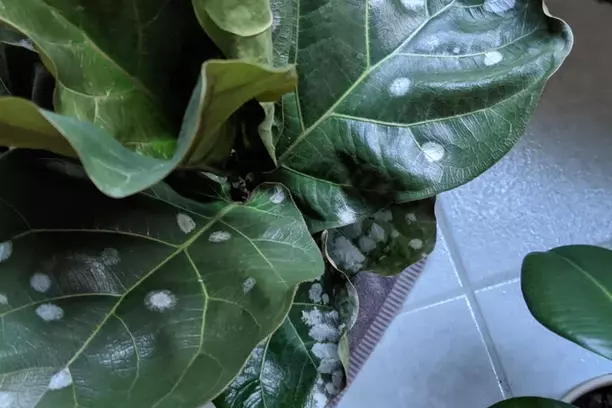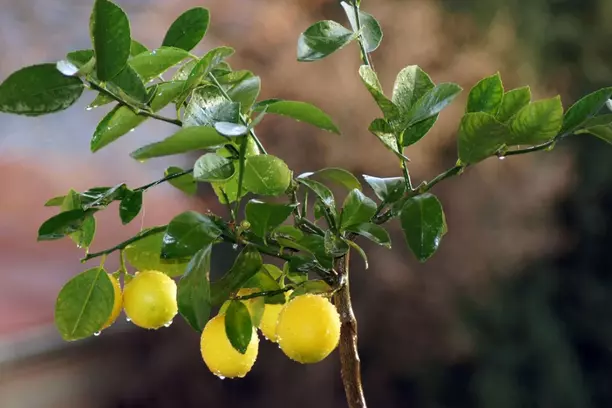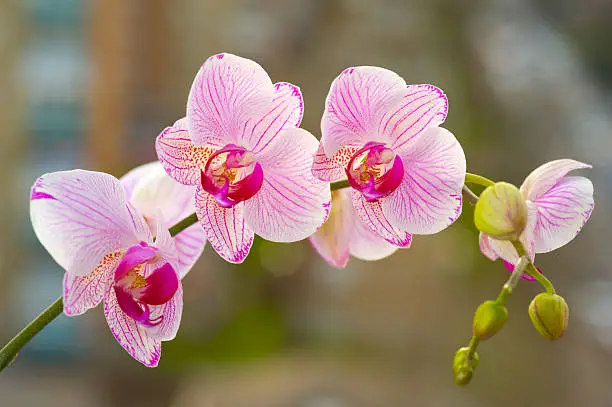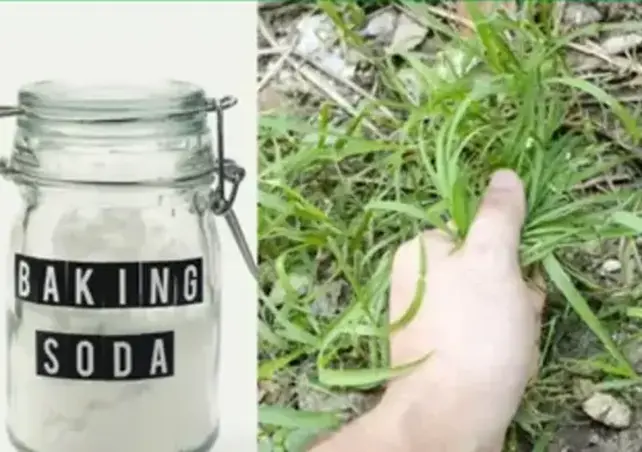It’s not uncommon to notice white marks on your fiddle leaf foliage, since there are numerous causative factors. The good news, though, is that you can get rid of these white spots by cleaning the leaves with soapy water and applying homemade fungicidal/insecticidal solutions.
Causes of white spots on fiddle leaf fig

If you notice any white marks on the leaves of your fiddle leaf fig, it’s an indicator that something is not right. White spots on Ficus lyrata may be caused by hard water damage, sunburn, pest infestation, and fungal infection.
Irrigation using hard water
The most common cause of white spots on the leaves of fiddle leaf figs is watering the plant with hard water. The white hard water spots usually have a chalky feel and cause the fiddle leaf fig leaves to lose their glossy appearance.
Hard water spots are caused by the buildup of mineral deposits (calcium, sodium, magnesium, chlorine) on the leaf blades of Ficus lyrata. These minerals are deposited on the leaf blades when you use hard water (tap water) to hydrate your fiddle leaf fig.
Fungal infection (powdery mildew)
Powdery mildew may also appear as white spots on the surface of the leaf blades of your Ficus lyrata. This fungal organism looks like a powdery and fleecy greyish-white blemish on the leaf surface. The tiny white spots eventually grow bigger and fleecier with time.
Powdery mildew is more likely to infect your fiddle leaf fig if the relative humidity around your plant is too high. This fungal species thrives in such humid conditions. If left unattended, powdery mildew will affect your plant’s health.
Overexposure to sunlight
White spots on the leaves of fiddle leaf fig may also be sunburn marks caused by exposing the plant to direct sunlight. This fig plant thrives in bright, indirect sunlight. However, direct sunlight will scorch the leaves.
You can distinguish white marks caused by sunburn from other types of white spots by checking the leaf blades for brown spots. It’s these brown marks that eventually turn white or yellow as the sunburn issue escalates.
Pest invasion
A variety of tiny-sized bugs that invade fiddle leaf figs may also appear as white spots to the naked eye. The most common of these are mealybugs, which appear as white, cotton-like spots on the fiddle leaf fig leaves. The white stuff is a protective layer of powdery wax that covers the insects’ bodies.
How to get rid of white spots on fiddle leaf figs

To effectively get rid of white spots on fiddle leaf figs, you need to start by determining the underlying cause. Depending on the causative factor, you can get rid of these white blemishes by cleaning the leaves with a soapy solution, spraying the plant with a baking soda solution, avoiding exposure to direct sunlight, or spraying the leaves with a rubbing alcohol solution.
Clean the leaves with a soapy solution
To get rid of the mineral deposits appearing as white spots on the leaves of fiddle leaf fig, clean the leaf blades using a soapy solution. Use detergent-free soap to avoid discoloring the leaves, and follow the procedure detailed below:
- Mix one teaspoon of detergent-free soap with 0.5 gallons of distilled water and stir the mixture.
- Transfer the solution into a spray bottle.
- Next, spray the solution onto the affected fiddle leaf fig leaves and leave it on the blades for about five minutes to break down the mineral deposits.
- Finish off by wiping the solution and the hard water spots off the Ficus lyrata leaf blades using a microfiber cloth.
Note: Avoid wiping the soapy solution off as you go along, as the solution should be left on the leaves for a while to fully work out the minerals.
Spray the plant with a baking soda solution
You can get rid of white powdery mildew fungi on the surface of fiddle leaf fig leaves by spraying the plant with a baking soda (sodium bicarbonate) solution. Used by itself, baking soda won’t effectively eliminate this fungal species on fiddle leaf fig plants. However, when combined with dormant oil and detergent-free soap, it’s as effective a fungicide as it gets.
Simply mix 2-3 teaspoons of baking soda, one teaspoon of dormant oil, a teaspoon of detergent-free liquid soap, and a gallon of water inside a bucket. Then, stir the mixture and transfer it to a spray bottle before spraying your Ficus lyrata leaves. You may have to undertake repeat applications every two weeks or so to eliminate the powdery mildew.
Other effective alternatives to baking soda solution include potassium bicarbonate, a mild vinegar solution, and ethanol-based mouthwash. Each of these options will kill powdery mildew spores upon contact.
Avoid exposing the plant to direct sunlight
When it comes to white spots on fiddle leaf figs caused by sunburn, there’s no treatment for the damage already caused. Your best option is to prune off the affected leaves. However, you can prevent further sunburn spots by taking several protective measures.
First off, if your Ficus lyrata is next to a window, install drapes to filter out direct sunlight. Alternatively, you may move the plant to a spot that receives bright, but indirect sunlight. Increasing humidity levels also helps to prevent sunburn in indoor fig plants.
Meanwhile, if you’re moving your plant from an indoor spot to an outdoor location, start by only exposing it to direct sunlight for a few hours, and gradually increase the duration of exposure each day. This will give the fiddle leaf fig time to slowly adjust to the increased sunlight conditions.
Spray the fiddle leaf fig plant with an organic pesticide
If the white spots are wax-covered mealybugs, you can get rid of them by spraying the fiddle leaf fig foliage with an insecticidal solution. A solution containing rubbing alcohol and dish soap is a good example of an effective, homemade mealybug killer.
Simply mix a cupful of 70% rubbing alcohol with a few drops of dish soap and 32 ounces of water. Next, transfer the solution into a spray bottle and spray the affected fiddle leaf fig leaves to kill the mealybugs. For maximum efficacy, spray the leaves at least twice a week until you get rid of all the mealybugs.
You can also control mealybug infestations by spraying the fiddle leaf fig foliage with neem oil solution every week or two. Finally, introducing beneficial insects like lacewings and ladybugs that feed on mealybugs will also help to control the mealybug populations.
References:
[1] Joey Williamson, Ph.D., HGIC Horticulture Extension Agent, Clemson University: Powdery Mildew on Plants



